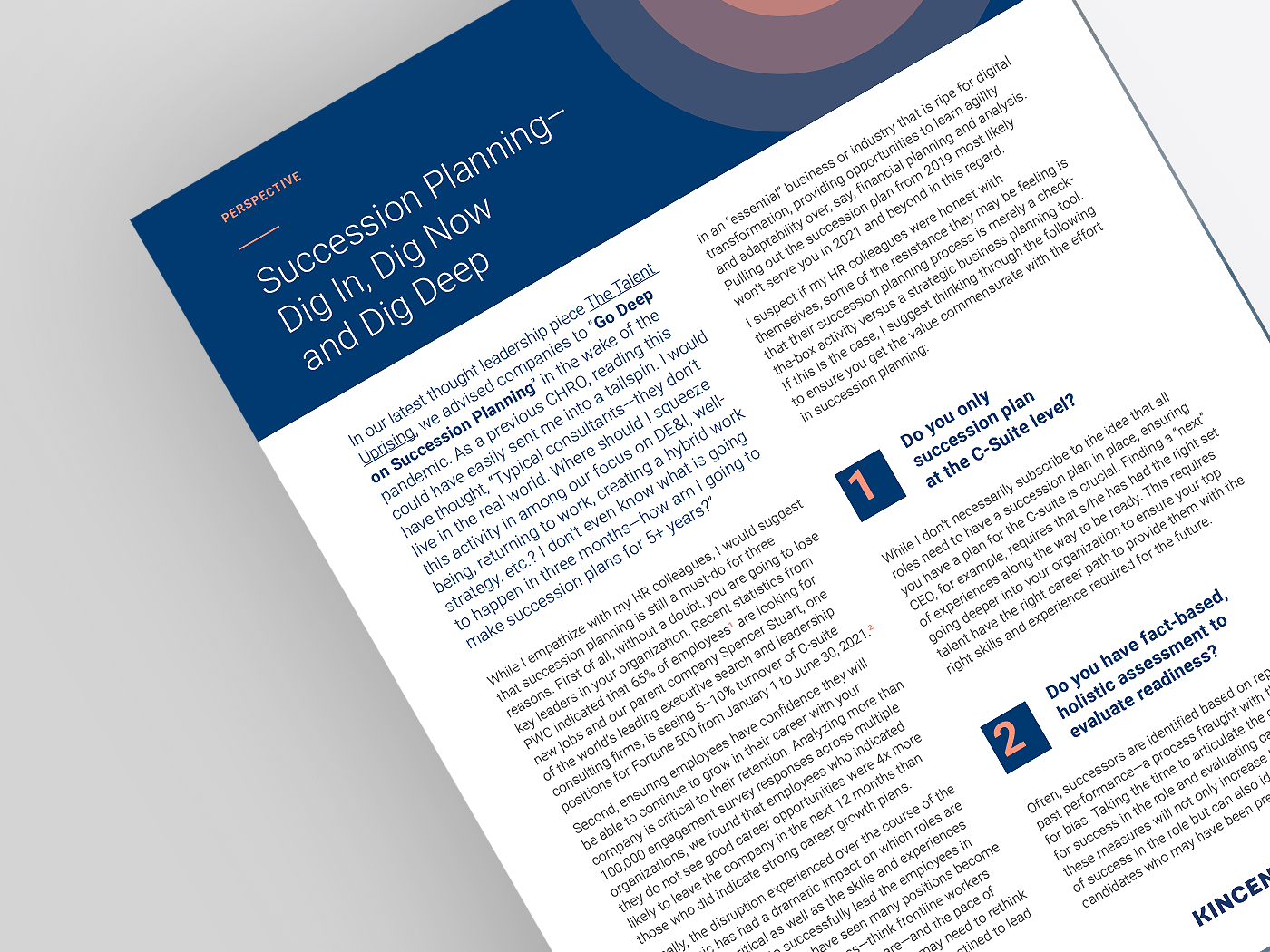
In our latest thought leadership piece The Talent Uprising, we advised companies to “Go Deep on Succession Planning” in the wake of the pandemic. As a previous CHRO, reading this could have easily sent me into a tailspin. I would have thought, “Typical consultants—they don’t live in the real world. Where should I squeeze this activity in among our focus on DE&I, well- being, returning to work, creating a hybrid work strategy, etc.? I don’t even know what is going to happen in three months—how am I going to make succession plans for 5+ years?”
While I empathize with my HR colleagues, I would suggest that succession planning is still a must-do for three reasons. First of all, without a doubt, you are going to lose key leaders in your organization. Recent statistics from PWC indicated that 65% of employees¹ are looking for new jobs and our parent company Spencer Stuart, one of the world’s leading executive search and leadership consulting firms, is seeing 5–10% turnover of C-suite positions for Fortune 500 companies from January 1 to June 30, 2021.²
Second, ensuring employees have confidence they will be able to continue to grow in their career with your company is critical to their retention. Analyzing more than 100,000 engagement survey responses across multiple organizations, we found that employees who indicated they do not see good career opportunities were 4x more likely to leave the company in the next 12 months than those who did indicate strong career growth plans.
Finally, the disruption experienced over the course of the pandemic has had a dramatic impact on which roles are considered critical as well as the skills and experiences that are required to successfully lead the employees in those critical roles. We have seen many positions become newly “critical” to the business—think frontline workers in retail and hospitality or healthcare—and the pace of change has been unprecedented. You may need to rethink the appropriate career path for someone destined to lead in an “essential” business or industry that is ripe for digital transformation, providing opportunities to learn agility and adaptability over, say, financial planning and analysis. Pulling out the succession plan from 2019 most likely won’t serve you in 2021 and beyond in this regard.
I suspect if my HR colleagues were honest with themselves, some of the resistance they may be feeling is that their succession planning process is merely a check- the-box activity versus a strategic business planning tool. If this is the case, I suggest thinking through the following to ensure you get the value commensurate with the effort in succession planning:
While I don’t necessarily subscribe to the idea that all roles need to have a succession plan in place, ensuring you have a plan for the C-suite is crucial. Finding a “next” CEO, for example, requires that s/he has had the right set of experiences along the way to be ready. This requires going deeper into your organization to ensure your top talent have the right career path to provide them with the right skills and experience required for the future.
Often, successors are identified based on reputation or past performance—a process fraught with the opportunity for bias. Taking the time to articulate the criteria required for success in the role and evaluating candidates against these measures will not only increase the likelihood of success in the role but can also identify potential candidates who may have been previously overlooked.
The ability to execute on a succession plan once a role opens is dependent on having a strategy to identify and prepare potential successors perhaps years before then. Going one or two levels deep now will ensure your pipeline can deliver in the future. Not only is it important to articulate the development needed, but clarifying the accountability for the leader or individual themselves to work the development plan will ensure that when the time comes, you have a plan you can execute against.
There is nothing worse than making great plans only to realize you don’t have the appropriate funding to support those efforts. It is critical that your people strategies align with your business strategies—and budgets.
Can you combine roles for a period of time? Can you restructure the role so that a successor can take it even if they aren’t fully ready, or split the responsibilities of the role among several potential successors? Thinking through these things “while you’re sober”—before the frenzy of trying to find a replacement—can ensure you are growing and developing the talent in your organization in a strategic fashion.

While I know there is enough work on HR teams’ plates right now to keep HR teams busy 24/7/365, ensuring you have a robust succession planning process is critical to retain key talent in your organization. Remember, if you aren’t willing to create and share the plans you have for an employee, you can bet recruiters and other companies will be!
1. PwC US Pulse Survey: Next in work
2. Spencer Stuart analysis of Fortune 500 top functional roles as reported in public sources.
Want the latest insights delivered straight to your mailbox?